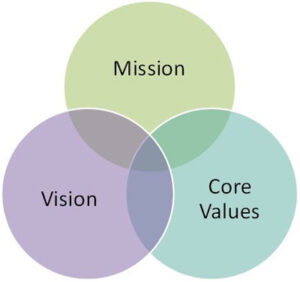The focus of this new year has been directed toward strategic objectives with a view toward strategic planning. This is where the rubber meets the road in your business. Strategic planning is a higher level of planning in your business that those goes well beyond simple goal-setting or even creating your strategic objectives.
You can look at your company’s strategic plan as the “prime directive” – the roadmap to creating a clear focus and direction in your overall strategy for success. The strategic planning process is what defines your company or organization’s strategy and direction and allows the key stakeholders to make the right decisions that will guide the company in the right direction – the direction of success! Without a strategic plan, your company becomes the proverbial ship without a rudder…or even the ship without a sail.
The Key Components of Strategic Planning 
There are four key components to the strategic planning process:
- Mission – Your company mission delineates the reason that it exists in the first place. What is your company really up to in the world?
- Vision – Your company vision clearly define how your company or organization wants to be in the world – focusing on the long-term view toward the future.
- Core Values – Your company values define the culture and beliefs that are shared among the stakeholders.
- Strategy – Your company’s strategy is the actual plan of execution that allows you to fulfill the strategic objectives (goals) and define the path to reach them.
Put very simply…your strategic plan should clearly answer the following questions:
- Who are we?
- Where are we (in the progression of our company goals)?
- What resources do we have to work with?
- Where do we want to be (again, in the progression of our company goals)?
- How are we going to get there?
When you can answer these key questions, you are well on your way to completing your strategic plan.
Creating Your Company Mission Statement
Your mission statement can be created in two simple steps…as long as you keep it simple and brief. First, describe what your company does. Straight ahead, to the point. Then, describe how you actually do that. The trick here is to try to complete the entire mission statement in a single sentence, so it is important that you don’t go into detail about how you do what you do.
An example of a clear mission statement might be:
“Worldwide Seminars creates powerful educational programs that help people to reach their full potential.”
Creating an Effective Vision Statement
One simple strategy for creating an effective vision statement is to use the “in five years from now, [your company name] will [accomplish this big vision] by [doing this work].
And you can start with your mission statement to create your vision statement.
For example, using the Worldwide Seminars example above, the broader, longer-term vision statement might be something like:
“Five years from now, Worldwide Seminars will change the way people reach their full potential by expanding its seminar program throughout 20 countries, becoming the premier education provider in the human potential marketplace.”
Discover Your Company’s Core Values
The first step toward understanding and defining your company’s core values is to get clear about your own…what are your values? What is the culture that you would like to see in your company. If you are an executive in your business, your values will ultimately reflect company values. Once you’ve defined your own values, you can then query others about their values. Then, simply combine the values that you discover…either by committee or individually. Test those values by asking yourself if you were willing to hire and/or fire people based on whether they actually fit your core company values. Now you have your core values and the foundation for your company’s culture.
What About Strategy?
Good news here…we’ve already discussed how to create powerful and effective strategic objectives in our previous two articles – now it is simply a matter of enrolling all the stakeholders involved with every area to create the actual strategies – the action items — that will smoothly transport you from where you are today to where you want to be. Use your strategic objectives as the launching pad for creating action strategy and your strategic planning process will be complete.
Right now is a great time to start scheduling out the strategic planning process for your business. Consider a company retreat (even if it’s just a day or half-day in-house) to bring all your key players into the conversation…collaboration inspires creativity and vision.
Above all, remember to have fun!

